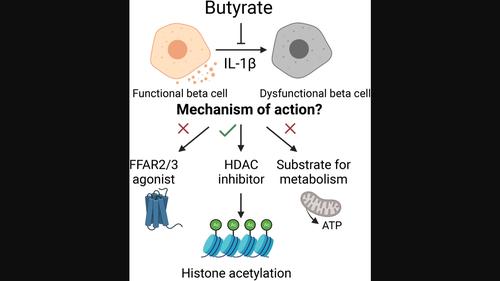Our official English website, www.x-mol.net, welcomes your feedback! (Note: you will need to create a separate account there.)
Butyrate functions as a histone deacetylase inhibitor to protect pancreatic beta cells from IL-1β-induced dysfunction
The FEBS Journal ( IF 5.4 ) Pub Date : 2023-11-20 , DOI: 10.1111/febs.17005 Signe Schultz Pedersen 1 , Lars Roed Ingerslev 2 , Mathias Olsen 1 , Michala Prause 1 , Nils Billestrup 1
The FEBS Journal ( IF 5.4 ) Pub Date : 2023-11-20 , DOI: 10.1111/febs.17005 Signe Schultz Pedersen 1 , Lars Roed Ingerslev 2 , Mathias Olsen 1 , Michala Prause 1 , Nils Billestrup 1
Affiliation

|
Butyrate, a gut microbial metabolite, has beneficial effects on glucose homeostasis and has become an attractive drug candidate for type 2 diabetes (T2D). Recently, we showed that butyrate protects pancreatic beta cells against cytokine-induced dysfunction. In this study, we explored the underlying mechanisms of butyrate action. Pancreatic mouse islets were exposed to a non-cytotoxic concentration of interleukin-1β (IL-1β) for 10 days to mimic low-grade inflammation in T2D. Similar to the effect of butyrate, an isoform-selective histone deacetylase 3 (HDAC3) inhibitor normalized IL-1β-reduced glucose-stimulated insulin secretion and insulin content. In contrast, free fatty acid receptor 2 and 3 (FFAR2/3) agonists failed to normalize IL-1β-induced beta cell dysfunction. Furthermore, butyrate inhibited HDAC activity and increased the acetylation of histone H3 and H4 by 3- and 10-fold, respectively. Genome-wide analysis of histone H3 lysine 27 acetylation (H3K27ac) revealed that butyrate mainly increased H3K27ac at promoter regions (74%), while H3K27ac peaks regulated by IL-1β were more equally distributed at promoters (38%), introns (23%) and intergenic regions (23%). Gene ontology analysis showed that butyrate increased IL-1β-reduced H3K27ac levels near several genes related to hormone secretion and reduced IL-1β-increased H3K27ac levels near genes associated with inflammatory responses. Butyrate alone increased H3K27ac near many genes related to MAPK signaling, hormone secretion, and differentiation, and decreased H3K27ac at genes involved in cell replication. Together, these results suggest that butyrate prevents IL-1β-induced pancreatic islet dysfunction by inhibition of HDACs resulting in changes in H3K27ac levels at genes relevant for beta cell function and inflammatory responses.
中文翻译:

丁酸盐作为组蛋白脱乙酰酶抑制剂,保护胰腺 β 细胞免受 IL-1β 诱导的功能障碍的影响
丁酸盐是一种肠道微生物代谢产物,对葡萄糖稳态具有有益作用,已成为治疗 2 型糖尿病 (T2D) 的有吸引力的候选药物。最近,我们发现丁酸盐可以保护胰腺β细胞免受细胞因子诱导的功能障碍。在这项研究中,我们探索了丁酸作用的潜在机制。将小鼠胰岛暴露于非细胞毒性浓度的白细胞介素 1β (IL-1β) 中 10 天,以模拟 T2D 中的低度炎症。与丁酸盐的作用类似,异构体选择性组蛋白脱乙酰酶 3 (HDAC3) 抑制剂可使 IL-1β 降低葡萄糖刺激的胰岛素分泌和胰岛素含量正常化。相比之下,游离脂肪酸受体 2 和 3 (FFAR2/3) 激动剂未能使 IL-1β 诱导的 β 细胞功能障碍正常化。此外,丁酸盐抑制 HDAC 活性,并使组蛋白 H3 和 H4 的乙酰化分别增加 3 倍和 10 倍。组蛋白 H3 赖氨酸 27 乙酰化 (H3K27ac) 的全基因组分析表明,丁酸主要在启动子区域 (74%) 增加 H3K27ac,而受 IL-1β 调节的 H3K27ac 峰更均匀地分布在启动子 (38%)、内含子 (23%) )和基因间区域(23%)。基因本体分析表明,丁酸盐增加了与激素分泌相关的多个基因附近的 IL-1β 减少的 H3K27ac 水平,并减少了与炎症反应相关的基因附近的 IL-1β 增加的 H3K27ac 水平。单独的丁酸盐会增加许多与 MAPK 信号、激素分泌和分化相关的基因附近的 H3K27ac,并减少与细胞复制有关的基因的 H3K27ac。总之,这些结果表明丁酸通过抑制 HDAC 导致与 β 细胞功能和炎症反应相关的基因的 H3K27ac 水平发生变化,从而防止 IL-1β 诱导的胰岛功能障碍。
更新日期:2023-11-20
中文翻译:

丁酸盐作为组蛋白脱乙酰酶抑制剂,保护胰腺 β 细胞免受 IL-1β 诱导的功能障碍的影响
丁酸盐是一种肠道微生物代谢产物,对葡萄糖稳态具有有益作用,已成为治疗 2 型糖尿病 (T2D) 的有吸引力的候选药物。最近,我们发现丁酸盐可以保护胰腺β细胞免受细胞因子诱导的功能障碍。在这项研究中,我们探索了丁酸作用的潜在机制。将小鼠胰岛暴露于非细胞毒性浓度的白细胞介素 1β (IL-1β) 中 10 天,以模拟 T2D 中的低度炎症。与丁酸盐的作用类似,异构体选择性组蛋白脱乙酰酶 3 (HDAC3) 抑制剂可使 IL-1β 降低葡萄糖刺激的胰岛素分泌和胰岛素含量正常化。相比之下,游离脂肪酸受体 2 和 3 (FFAR2/3) 激动剂未能使 IL-1β 诱导的 β 细胞功能障碍正常化。此外,丁酸盐抑制 HDAC 活性,并使组蛋白 H3 和 H4 的乙酰化分别增加 3 倍和 10 倍。组蛋白 H3 赖氨酸 27 乙酰化 (H3K27ac) 的全基因组分析表明,丁酸主要在启动子区域 (74%) 增加 H3K27ac,而受 IL-1β 调节的 H3K27ac 峰更均匀地分布在启动子 (38%)、内含子 (23%) )和基因间区域(23%)。基因本体分析表明,丁酸盐增加了与激素分泌相关的多个基因附近的 IL-1β 减少的 H3K27ac 水平,并减少了与炎症反应相关的基因附近的 IL-1β 增加的 H3K27ac 水平。单独的丁酸盐会增加许多与 MAPK 信号、激素分泌和分化相关的基因附近的 H3K27ac,并减少与细胞复制有关的基因的 H3K27ac。总之,这些结果表明丁酸通过抑制 HDAC 导致与 β 细胞功能和炎症反应相关的基因的 H3K27ac 水平发生变化,从而防止 IL-1β 诱导的胰岛功能障碍。



























 京公网安备 11010802027423号
京公网安备 11010802027423号